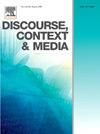“So fast on the keys, when do you have time to meet”: Interactionally generated invitations in Danish Tinder chats
IF 3.1
2区 文学
Q1 COMMUNICATION
引用次数: 0
Abstract
This paper investigates how Tinder users in Denmark interactionally generate invitations to meet through post-match chats. Based on a collection of 194 Tinder chats collected in 2020, from which 19 examples involving invitations were identified and analyzed using methodology inspired by Conversation Analysis focusing on the strategies used to navigate the delicate process of proposing a meeting.
The paper analyzed three ways of generating invitations interactionally: 1) interpreting response time as an indicator of interest, where quick replies are taken as signs of engagement and willingness to meet; 2) basing the invitation on contextually favorable conditions, such as weather or proximity, which are framed as low-effort and convenient for the recipient; and 3) utilizing self-disclosure to propose meeting activities that align with the recipient’s preferences or personal information revealed during the chat.
These strategies allow users to test the waters before asking for a meeting, thus minimizing the likelihood of rejection. By treating invitations as collaborative actions, where the recipient’s interest is implied rather than directly solicited, users manage the potential social risks involved in proposing face-to-face interactions. The findings highlight the unique affordances of Tinder as a platform, such as timestamps and geolocation features, which shape the way invitations are constructed and understood. This study contributes to existing research on digital communication by showing how invitations in online dating are interactionally achieved through subtle, recipient-designed strategies that exploit the app’s features while preserving face and mitigating social risks.
“按键这么快,你什么时候有时间见面?”:丹麦Tinder聊天中的互动生成邀请
本文调查了丹麦Tinder用户如何通过赛后聊天互动地生成邀请。基于2020年收集的194个Tinder聊天记录,其中19个涉及邀请的例子被识别出来,并使用受对话分析启发的方法进行了分析,重点是用于引导提议会议的微妙过程的策略。本文分析了互动生成邀请的三种方式:1)将响应时间视为兴趣指标,快速回复被视为参与和愿意见面的标志;2)将邀请建立在环境有利条件的基础上,例如天气或邻近,这对接受者来说是不费力和方便的;3)利用自我披露来提出符合接收者偏好或聊天过程中透露的个人信息的会议活动。这些策略可以让用户在要求见面之前先试水,从而最大限度地减少被拒绝的可能性。通过将邀请视为协作行为,接收方的兴趣是隐含的而不是直接征求的,用户可以管理提议面对面互动所涉及的潜在社会风险。这些发现突出了Tinder作为一个平台的独特功能,比如时间戳和地理位置功能,这些功能塑造了邀请的构建和理解方式。这项研究通过展示在线约会中的邀请是如何通过微妙的、收件人设计的策略来互动地实现的,从而为现有的数字通信研究做出了贡献,这些策略利用了应用程序的功能,同时保留了面子并降低了社会风险。
本文章由计算机程序翻译,如有差异,请以英文原文为准。
求助全文
约1分钟内获得全文
求助全文

 求助内容:
求助内容: 应助结果提醒方式:
应助结果提醒方式:


